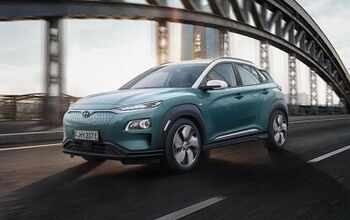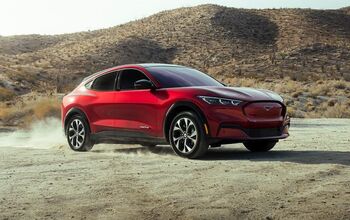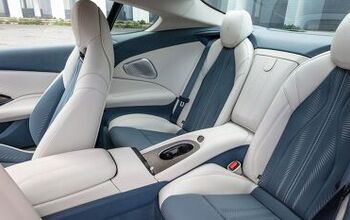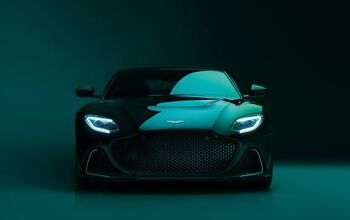NAIAS Winners And Losers
2013’s edition of the Detroit Auto Show is the first I’ve covered for TTAC, and it serves as a nice break from the world of low-cost cars, overcapacity and Bertel’s daily demands for Facebook photos of my attractive female friends. Since I was the sole journalist covering the show, most of the coverage was limited to photos and a brief bit of information on the car. But since you all come here to read my semi-informed pontifications for some added context regarding the auto industry I’ve assembled this handy guide to NAIAS 2013, free of any regurgitated press release info or PR pap. Enjoy, and send any angry criticisms/threats of press fleet acesses revocation to derek at ttac dot com
Winner – Ford: Without a doubt, the big winner at NAIAS is Ford. The F-150 is America’s best-selling vehicle, and the Atlas concept is an early preview of what to expect. Sources tell me that the concept was so hush-hush that most employees heard about it only through Ford’s internal news channels or car blogs. The same source claims that while things like wheel-mounted active aero shutters are still in flux, we will see more exotic metals like aluminum and magnesium in play for the next F-Series.
Winner- Cadillac: The General’s lone bright spot at the show. Cadillac’s ELR is what an advanced hybrid/electric/range extender (whatever you want to call it) vehicle should look like. Power is up, all-electric range is down (due to the 20″ wheels and increased power perhaps?) and if enough celebrities are seen driving it, it could be the next status symbol for those wealthy enough to advocate for green causes. The ATS also won North American Car of the Year. Not my choice, but another trophy for GM’s cabinet.
Winner – VW/Audi: VW and Audi were mobbed for so long after their press conferences that it was hard to get photos of their debuts (which will come later). Volkswagen debuted a new Crossover concept with three rows of seats, while Audi debuted the SQ5 and the RS7. All of the vehicles on the Audi stand were immensely desirable and made the BMW and Mercedes products look like reasonable facsimiles of desirable luxury vehicles. I am more convinced than ever that Volkswagen Group’s goal of 1 million units in America by 2018 is feasible, and Audi will likely reach their 200,000 unit sales goal as well.
Loser – Electric Vehicles: Where were the EVs? Nissan announced a price drop for the Leaf to $28,200, but that was the big news for EVs. Tesla had a Model X on display, but its profile was minimal compared to pretty much every other product at the show. While hybrid powertrains continue to go from strength to strength, EVs are slowly losing their grasp of the limelight, existing largely as a PR/Government relations tool rather than a viable transportation alternative.
Loser – Mercedes-Benz/BMW: The unrelenting thirst for volume comes in the form of brand-debasing cheapo lease specials. The CLA and 320i will sell…err, lease, in serious numbers to legions of insecure strivers who can pay $399 a month. But at what cost to the “premium” image of the two brands?
Loser – Chevrolet: Reaction to the C7 Corvette has been “mixed”. Reaction on the internet was positive, but the buzz on the show floor was not as enthusiastic. Personally, I think it is overwrought, riddled with too many vents and gills and crap. Yes, the interior has been improved…at the expense of the exterior. The GM trucks are just as underwhelming in person as they are in photos, and they stayed locked for most of the press days. Not an encouraging sign. With the Ram 1500 now competitive, and the F-150 as good as ever “good enough” is a recipe for diminishing market share in the full-size truck market.
Draw – Infiniti Q50/Lexus IS: Two new luxury sedans competing in the same class. The Infiniti’s exterior is striking and agressive, while the Lexus has the better interior. Traditionally, the Lexus could be written off as the inferior car for the enthusiastic driver – but with the overall competence of the GS, it’s impossible to rule the Lexus.
Draw – Hyundai HCD 14 Genesis Concept/ Acura RLX: A Hyundai source tells me that a lot of the outlandish details of the HCD 14, will not make it to production, but the next generation Genesis will not be as staid and generic as the current car. Let’s hope the overall profile remains, but that front grille has got to go. Meanwhile at Acura, the RLX was utterly ignored, no thanks to the generic exterior styling. Inside, however, is a different story. The cabin is beautifully finished, with immense amounts of leg room in the rear seat. You really feel like you’re in a luxury car. The SH-AWD could be a ground breaking car technologically, but I can’t imagine this car selling in any sort of volume.
Draw – Honda: Honda was back…and nobody noticed. The Accord is riding high on a wave of praise, the Civic is no longer the automotive media’s official whipping boy and the NSX could be viewed up close by appointment only. And the appointment book was pretty much full. Yet nobody seemed to pay too much attention to Honda’s new debuts, from the RLX, the MDX (nearly identical to the current version) and the Urban SUV Concept (a surprisingly fresh and interesting design from a company not known for such things).
More by Derek Kreindler
Latest Car Reviews
Read moreLatest Product Reviews
Read moreRecent Comments
- Jeffrey Henry Ford said about innovation, “ If I had asked my customers what they wanted, then they would have said a faster horse." Change is inevitable!!!https://www.wri.org/insights/countries-adopting-electric-vehicles-fastest#:~:text=Currently%2C%2016%20countries%2C%20including%20Canada,create%20and%20enforce%20such%20policies.
- ToolGuy If these guys opened a hotel outside Cincinnati I would go there to sleep, and to dream.
- ToolGuy Michelin's price increases mean that my relationship with them as a customer is not sustainable. 🙁
- Kwik_Shift_Pro4X I wonder if Fiat would pull off old world Italian charm full of well intentioned stereotypes.
- Chelsea I actually used to work for this guy


































Comments
Join the conversation
The critics of the C7 are the same people who will never buy one. It is for a new generation, but then these same kids don't get licences until they "have to drive to work", maybe 18 or 21? They really want cars that drive themselves, so they can keep texting and surfing on iPhones, pads, whatever.
I agree that the Corvette is overdone. I really don't care for all the creases on everything nowadays. But the worst part IMO is that they made it look like a family member of the Camaro, and that's a step in the wrong direction.